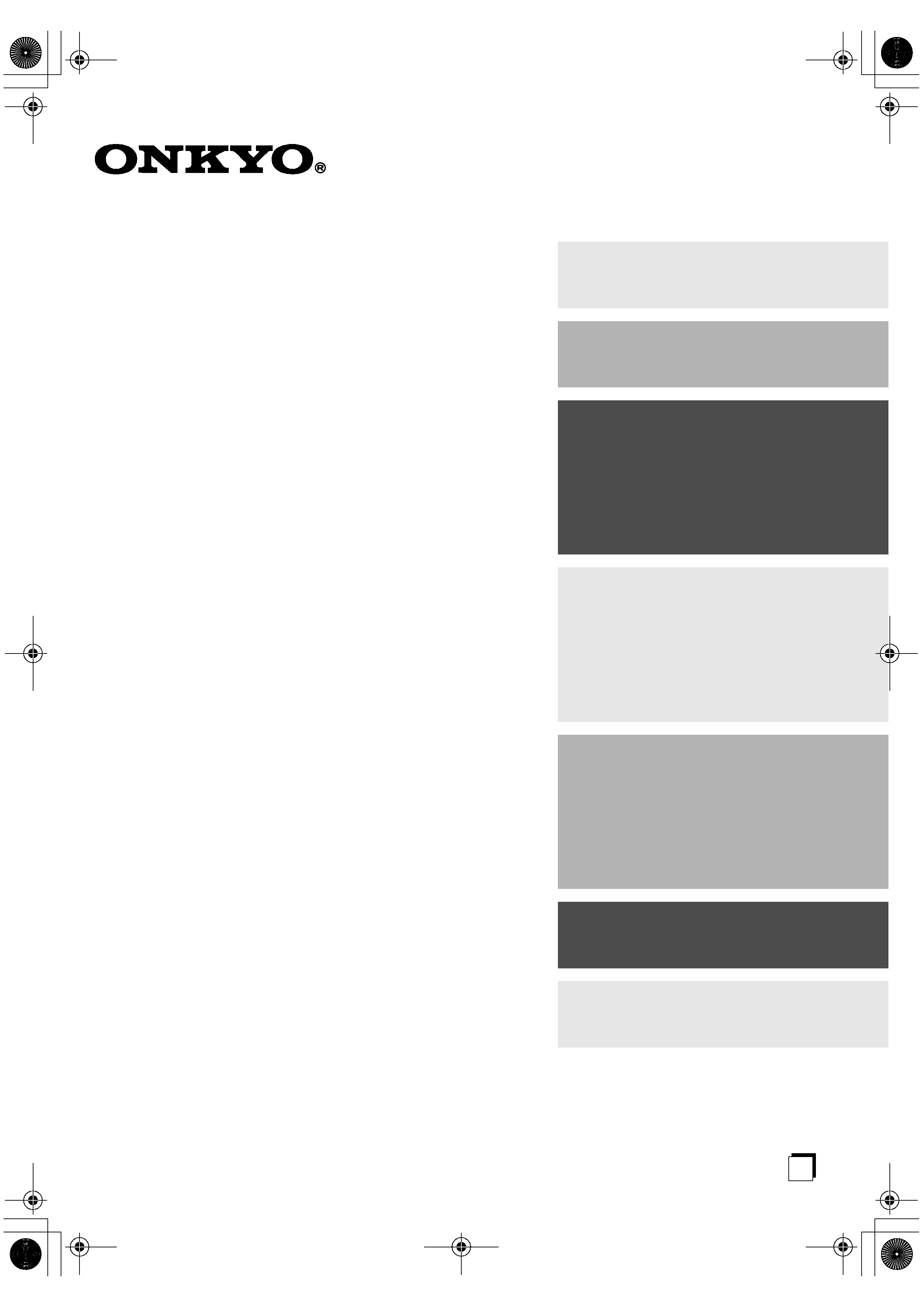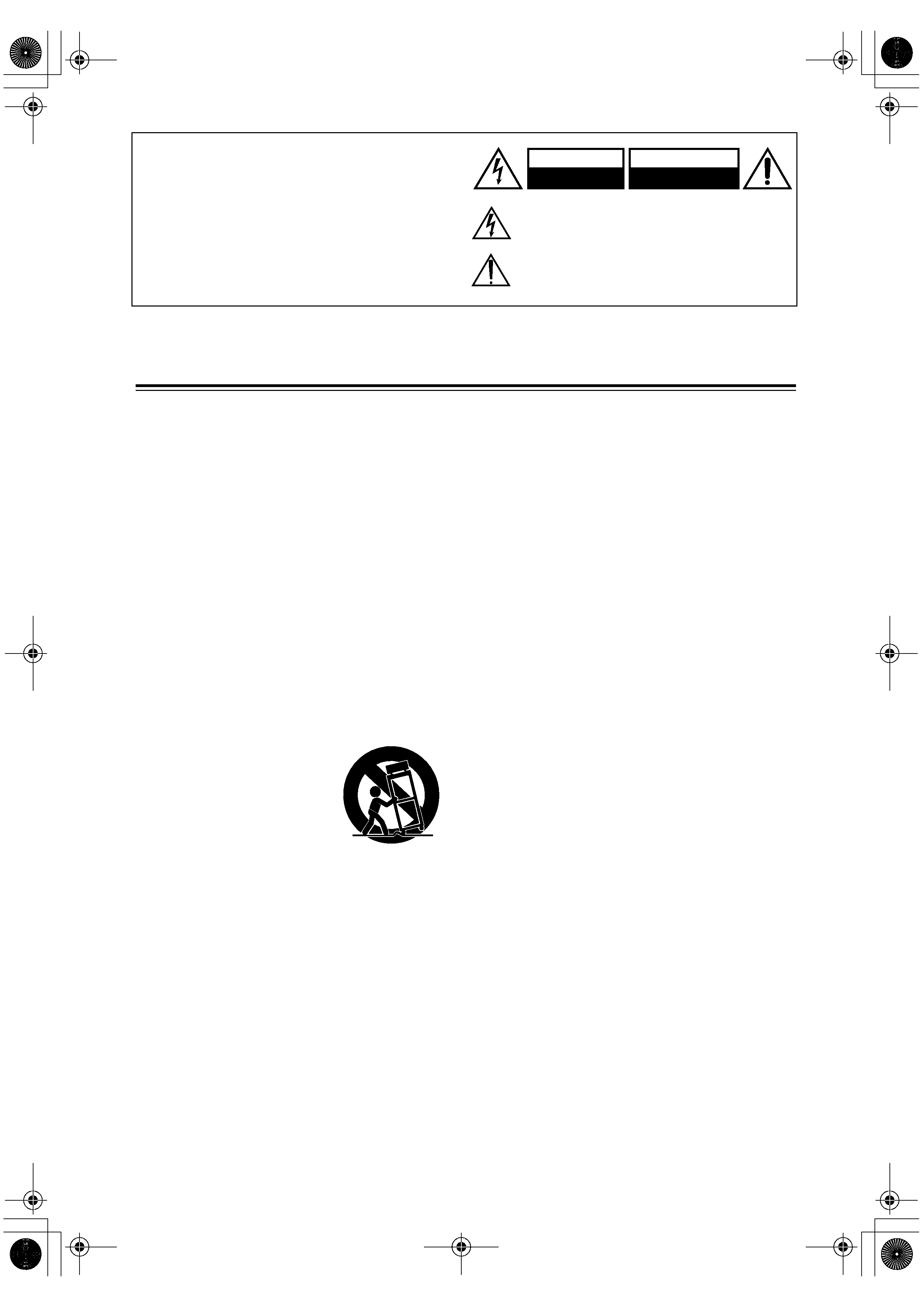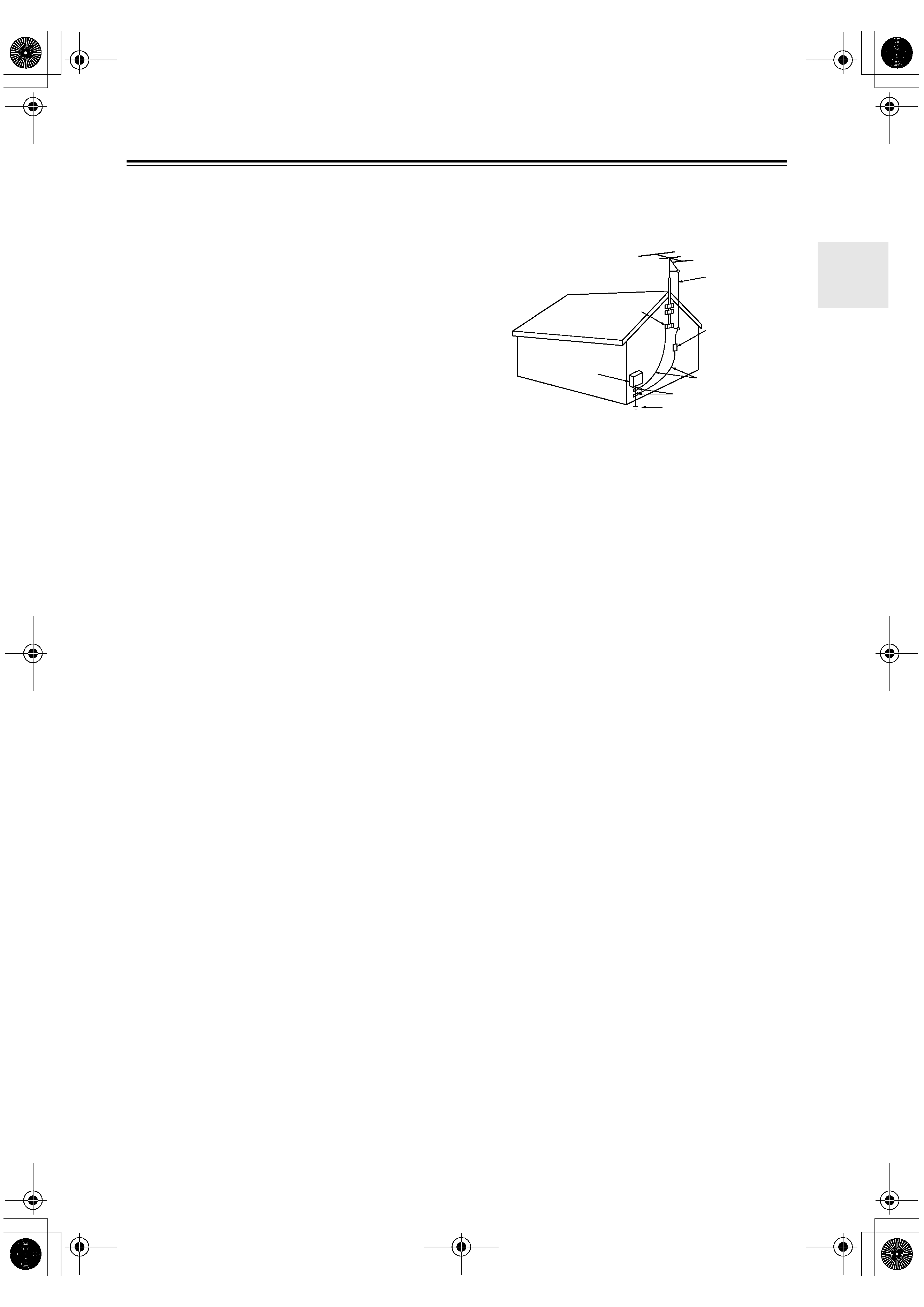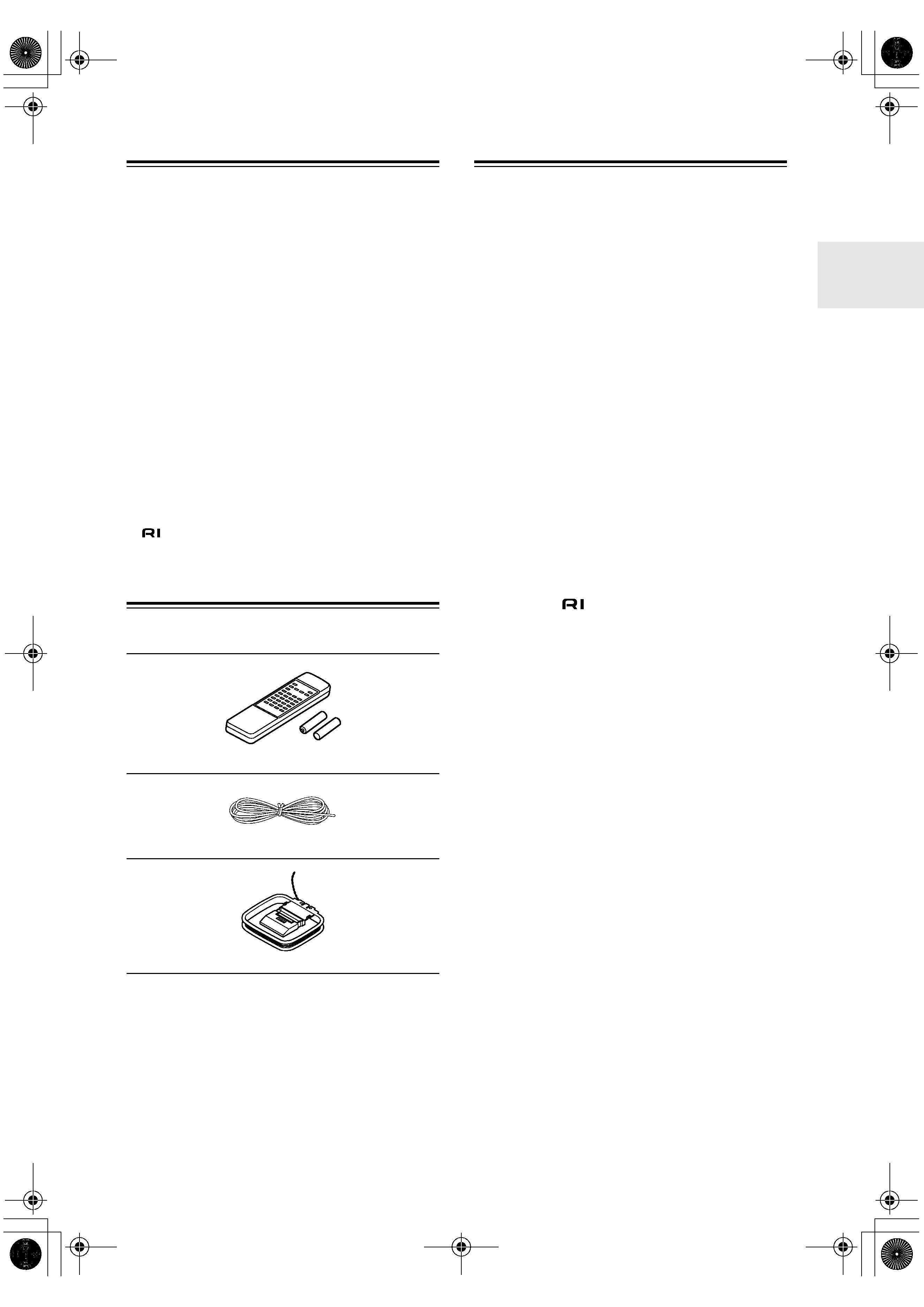
En
Stereo Receiver
TX-8011
Instruction Manual
Thank you for purchasing an Onkyo Stereo Receiver.
Please read this manual thoroughly before making
connections and plugging in the unit.
Following the instructions in this manual will enable
you to obtain optimum performance and listening
enjoyment from your new Stereo Receiver.
Please retain this manual for future reference.
Contents
Introduction ..................................... 2
Connection .................................... 11
Playing Your Components ........... 17
Using the Tuner ............................. 19
Recording ...................................... 21
Troubleshooting ............................ 22
Specifications................................ 23

2
Important Safeguards
1. Read Instructions--All the safety and operating
instructions should be read before the appliance is
operated.
2. Retain Instructions--The safety and operating
instructions should be retained for future reference.
3. Heed Warnings--All warnings on the appliance and
in the operating instructions should be adhered to.
4. Follow Instructions--All operating and use
instructions should be followed.
5. Cleaning--Unplug the appliance from the wall out-
let before cleaning. The appliance should be cleaned
only as recommended by the manufacturer.
6. Attachments--Do not use attachments not recom-
mended by the appliance manufacturer as they may
cause hazards.
7. Water and Moisture--Do not use the appliance
near water for example, near a bath tub, wash bowl,
kitchen sink, or laundry tub; in a wet basement; or
near a swimming pool; and the like.
8. Accessories--Do not place
the appliance on an unstable
cart, stand, tripod, bracket,
or table. The appliance may
fall, causing serious injury
to a child or adult, and seri-
ous damage to the appli-
ance. Use only with a cart,
stand, tripod, bracket, or table recommended by the
manufacturer, or sold with the appliance. Any mount-
ing of the appliance should follow the manufacturer's
instructions, and should use a mounting accessory
recommended by the manufacturer.
9. An appliance and cart combination should be moved
with care. Quick stops, excessive force, and uneven
surfaces may cause the appliance and cart combina-
tion to overturn.
10. Ventilation--Slots and openings in the cabinet are
provided for ventilation and to ensure reliable opera-
tion of the appliance and to protect it from overheating,
and these openings must not be blocked or covered.
The openings should never be blocked by placing the
appliance on a bed, sofa, rug, or other similar surface.
The appliance should not be placed in a built-in instal-
lation such as a bookcase or rack unless proper ventila-
tion is provided. There should be free space of at least
8 in. (20 cm) and an opening behind the appliance.
11. Power Sources--The appliance should be operated
only from the type of power source indicated on the
marking label. If you are not sure of the type of
power supply to your home, consult your appliance
dealer or local power company.
12. Grounding or Polarization--The appliance may
be equipped with a polarized alternating current line
plug (a plug having one blade wider than the other).
This plug will fit into the power outlet only one way.
This is a safety feature. If you are unable to insert the
plug fully into the outlet, try reversing the plug. If the
plug should still fail to fit, contact your electrician to
replace your obsolete outlet. Do not defeat the safety
purpose of the polarized plug.
13. Power Cord Protection--Power-supply cords
should be routed so that they are not likely to be
walked on or pinched by items placed upon or
against them, paying particular attention to cords at
plugs, convenience receptacles, and the point where
they exit from the appliance.
14. Outdoor Antenna Grounding--If an outside
antenna or cable system is connected to the appli-
ance, be sure the antenna or cable system is grounded
so as to provide some protection against voltage
surges and built-up static charges. Article 810 of the
National Electrical Code, ANSI/NFPA 70, provides
information with regard to proper grounding of the
mast and supporting structure, grounding of the lead-
in wire to an antenna-discharge unit, size of ground-
ing conductors, location of antenna-discharge unit,
connection to grounding electrodes, and require-
ments for the grounding electrode. See Figure 1.
15. Lightning--For added protection for the appliance
during a lightning storm, or when it is left unattended
and unused for long periods of time, unplug it from
the wall outlet and disconnect the antenna or cable
system. This will prevent damage to the appliance
due to lightning and power-line surges.
16.Power Lines--An outside antenna system should
not be located in the vicinity of overhead power lines
or other electric light or power circuits, or where it
can fall into such power lines or circuits. When
installing an outside antenna system, extreme care
should be taken to keep from touching such power
lines or circuits as contact with them might be fatal.
WARNING:
TO REDUCE THE RISK OF FIRE OR ELECTRIC SHOCK,
DO NOT EXPOSE THIS APPLIANCE TO RAIN OR
MOISTURE.
CAUTION:
TO REDUCE THE RISK OF ELECTRIC SHOCK, DO NOT
REMOVE COVER (OR BACK). NO USER-SERVICEABLE
PARTS INSIDE. REFER SERVICING TO QUALIFIED
SERVICE PERSONNEL.
The lightning flash with arrowhead symbol, within an equilateral
triangle, is intended to alert the user to the presence of uninsulated
"dangerous voltage" within the product's enclosure that may be of
sufficient magnitude to constitute a risk of electric shock to persons.
The exclamation point within an equilateral triangle is intended to
alert the user to the presence of important operating and maintenance
(servicing) instructions in the literature accompanying the appliance.
WARNING
RISK OF ELECTRIC SHOCK
DO NOT OPEN
RISQUE DE CHOC ELECTRIQUE
NE PAS
OUVRIR
AVIS
PORTABLE CART WARNING
S3125A

3
Important Safeguards--Continued
17. Overloading--Do not overload wall outlets, exten-
sion cords, or integral convenience receptacles as
this can result in a risk of fire or electric shock.
18. Object and Liquid Entry--Never push objects of
any kind into the appliance through openings as they
may touch dangerous voltage points or short-out
parts that could result in a fire or electric shock.
Never spill liquid of any kind on the appliance.
19. Servicing--Do not attempt to service the appliance
yourself as opening or removing covers may expose
you to dangerous voltage or other hazards. Refer all
servicing to qualified service personnel.
20. Damage Requiring Service--Unplug the appliance
from the wall outlet and refer servicing to qualified
service personnel under the following conditions:
A. When the power-supply cord or plug is damaged,
B. If liquid has been spilled, or objects have fallen into
the appliance,
C. If the appliance has been exposed to rain or water,
D. If the appliance does not operate normally by follow-
ing the operating instructions. Adjust only those con-
trols that are covered by the operating instructions as
an improper adjustment of other controls may result
in damage and will often require extensive work by
a qualified technician to restore the appliance to its
normal operation,
E. If the appliance has been dropped or damaged in any
way, and
F. When the appliance exhibits a distinct change in per-
formance this indicates a need for service.
21. Replacement Parts--When replacement parts are
required, be sure the service technician has used
replacement parts specified by the manufacturer or
have the same characteristics as the original part.
Unauthorized substitutions may result in fire, elec-
tric shock, or other hazards.
22. Safety Check--Upon completion of any service or
repairs to the appliance, ask the service technician to
perform safety checks to determine that the appli-
ance is in proper operation condition.
23. Wall or Ceiling Mounting--The appliance should
be mounted to a wall or ceiling only as recom-
mended by the manufacturer.
24. Heat--The appliance should be situated away from
heat sources such as radiators, heat registers, stoves,
or other appliances (including amplifiers) that pro-
duce heat.
25. Liquid Hazards--The appliance should not be
exposed to dripping or splashing and no objects
filled with liquids, such as vases should be placed on
the appliance.
FIGURE 1:
EXAMPLE OF ANTENNA GROUNDING AS PER
NATIONAL ELECTRICAL CODE, ANSI/NFPA 70
ANTENNA
DISCHARGE UNIT
(NEC SECTION 810-20)
GROUNDING CONDUCTORS
(NEC SECTION 810-21)
GROUND CLAMPS
POWER SERVICE GROUNDING
ELECTRODE SYSTEM
(NEC ART 250, PART H)
NEC NATIONAL ELECTRICAL CODE
ELECTRIC
SERVICE
EQUIPMENT
GROUND
CLAMP
ANTENNA
LEAD IN
WIRE
S2898A

4
Precautions
1. Recording Copyright--Unless it's for personal use
only, recording copyrighted material is illegal with-
out the permission of the copyright holder.
2. AC Fuse--The AC fuse inside the TX-8011
Receiver is not user-serviceable. If you cannot turn
on the TX-8011 Receiver, contact your Onkyo
dealer.
3. Care--Occasionally you should dust the TX-8011
Receiver all over with a soft cloth. For stubborn
stains, use a soft cloth dampened with a weak solu-
tion of mild detergent and water. Dry the TX-8011
Receiver immediately afterwards with a clean cloth.
Don't use abrasive cloths, thinners, alcohol, or other
chemical solvents, because they may damage the
finish or remove the panel lettering.
4. Power
WARNING
BEFORE PLUGGING IN THE UNIT FOR THE
FIRST TIME, READ THE FOLLOWING SEC-
TION CAREFULLY.
AC outlet voltages vary from country to country.
Make sure that the voltage in your area meets the
voltage requirements printed on the TX-8011
Receiver's rear panel (e.g., AC 230 V, 50 Hz or AC
120 V, 60 Hz).
Setting the [STANDBY/ON] switch to STANDBY
does not fully shutdown the TX-8011 Receiver. If
you do not intend to use the TX-8011 Receiver for
an extended period, remove the power cord from the
AC outlet.
Memory backup
The TX-8011 uses a battery-less memory backup sys-
tem in order to retain radio presets and other settings
when it's unplugged or in the case of a power failure.
Although no batteries are required, the TX-8011
Receiver must be plugged into an AC outlet in order to
charge the backup system.
Once it has been charged, the TX-8011 Receiver will
retain the settings for several weeks, although this
depends on the environment and will be shorter in
humid climates.
For U.S. models
Note to CATV system installer:
This reminder is provided to call the CATV system
installer's attention to Section 820-40 of the NEC which
provides guideline for proper grounding and, in particu-
lar, specified that the cable ground shall be connected to
the grounding system of the building, as close to the
point of cable entry as practical.
FCC Information for User
CAUTION:
The user changes or modifications not expressly
approved by the party responsible for compliance could
void the user's authority to operate the equipment.
NOTE:
This equipment has been tested and found to comply
with the limits for a Class B digital device, pursuant to
Part 15 of the FCC Rules. These limits are designed to
provide reasonable protection against harmful interfer-
ence in a residential installation.
This equipment generates, uses and can radiate radio
frequency energy and, if not installed and used in accor-
dance with the instructions, may cause harmful interfer-
ence to radio communications. However, there is no
guarantee that interference will not occur in a particular
installation. If this equipment does cause harmful inter-
ference to radio or television reception, which can be
determined by turning the equipment off and on, the
user is encouraged to try to correct the interference by
one or more of the following measures:
· Reorient or relocate the receiving antenna.
· Increase the separation between the equipment and
receiver.
· Connect the equipment into an outlet on a circuit dif-
ferent from that to which the receiver is connected.
· Consult the dealer or an experienced radio/TV tech-
nician for help.
For Canadian models
For models having a power cord with a polarized plug:
CAUTION: TO PREVENT ELECTRIC SHOCK,
MATCH WIDE BLADE OF PLUG TO WIDE SLOT,
FULLY INSERT.
Modèle pour les Canadien
Sur les modèles dont la fiche est polarisee:
ATTENTION: POUR ÉVITER LES CHOCS ÉLEC-
TRIQUES, INTRODUIRE LA LAME LA PLUS
LARGE DE LA FICHE DANS LA BORNE CORRE-
SPONDANTE DE LA PRISE ET POUSSER
JUSQU'AU FOND.

5
Features
· 50 W/ch min. RMS at 8 ohms, both channels driven
from 20 Hz to 20 kHz, with no more than 0.08% THD.
· Discrete output stage circuits for true high-current,
low-impedance drive.
· Expensive, high-quality parts, such as high-power
transistors, an oversized power transformer, and heavy
duty extruded heatsink, make it possible to accurately
and effortlessly drive 4-ohm speakers.
·4 audio inputs
· A/B speaker selectors and outputs
· Cassette tape dubbing capability
· 30 FM/AM radio presets
· Preset scan tuning
·3 radio preset groups (10 presets per group)
· Direct access tuning
· Motorized, precision volume control
· Headphone jack
· Audio mute, sleep timer (via remote)
· Battery-free memory backup
·
compatible remote control
Supplied Accessories
Make sure you have the following accessories:
* In catalogs and on packaging, the letter added to the end of
the product name indicates the color of the TX-8011. Spec-
ifications and operation are the same regardless of color.
Contents
Important Safeguards........................................ 2
Precautions ........................................................ 4
Features.............................................................. 5
Supplied Accessories ....................................... 5
Contents ............................................................. 5
Front & Rear Panels .......................................... 6
Front Panel........................................................ 6
Display............................................................... 7
Rear Panel ........................................................ 8
Remote Controller ............................................. 9
Installing the Batteries ..................................... 10
Using the Remote Controller ........................... 10
Connections ..................................................... 11
Connecting Speakers ...................................... 11
Connecting the Supplied FM & AM Indoor
Antennas ......................................................... 12
Connecting an Outdoor FM Antenna............... 13
Connecting an Outdoor AM Antenna .............. 13
Connecting a CD Player.................................. 14
Connecting a Cassette Recorder .................... 14
Connecting a Turntable ................................... 14
Connecting
Components ......................... 15
Connecting the Power Cord of Another
Component...................................................... 15
Connecting the Power Cord ............................ 16
Turning On the TX-8011.................................. 16
Playing Your Components.............................. 17
Selecting the Source Component.................... 17
Using a Graphic Equalizer............................... 17
Adjusting the Bass, Treble & Balance ............. 17
Muting the TX-8011......................................... 17
Using the Sleep Timer..................................... 18
Using Headphones.......................................... 18
Using the Tuner ............................................... 19
Listening to the Radio...................................... 19
Tuning into Radio Stations .............................. 19
Presetting Radio Stations................................ 20
Selecting Presets ............................................ 20
Deleting Presets .............................................. 20
Recording ......................................................... 21
Recording the Input Source............................. 21
Tape-to-tape Dubbing ..................................... 21
Monitoring While Recording ............................ 21
Troubleshooting .............................................. 22
Power .............................................................. 22
Audio ............................................................... 22
Tuner ............................................................... 22
Remote Controller ........................................... 22
Specifications .................................................. 23
Remote controller (RC-330S) & two batteries (AA/R6)
Indoor FM antenna
AM loop antenna
